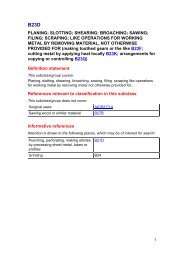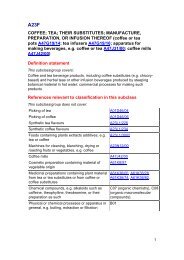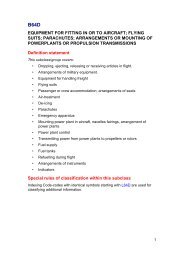A61K - Cooperative Patent Classification
A61K - Cooperative Patent Classification
A61K - Cooperative Patent Classification
You also want an ePaper? Increase the reach of your titles
YUMPU automatically turns print PDFs into web optimized ePapers that Google loves.
CPC - <strong>A61K</strong> - 2013.07 - page 18<br />
<strong>A61K</strong> 9/7007 . . { Drug-containing films, membranes or sheets ( <strong>A61K</strong> 9/0041 , <strong>A61K</strong> 9/0043 , <strong>A61K</strong><br />
9/006 , <strong>A61K</strong> 9/0063 take precedence ) }<br />
<strong>A61K</strong> 9/7015 . . { Drug-containing film-forming compositions, e.g. spray-on }<br />
<strong>A61K</strong> 9/7023 . . { Transdermal patches and similar drug-containing composite devices, e.g.<br />
cataplasms ( galenical aspects of iontophoretic devices <strong>A61K</strong> 9/0009 ; microneedle<br />
arrays <strong>A61K</strong> 9/0021 ; buccal patches <strong>A61K</strong> 9/006 ) }<br />
<strong>A61K</strong> 9/703 . . . { characterised by shape or structure; Details concerning release liner or<br />
backing; Refillable patches; User-activated patches }<br />
<strong>A61K</strong> 9/7038 . . . . { Transdermal patches of the drug-in-adhesive type, i.e. comprising drug in<br />
the skin-adhesive layer }<br />
<strong>A61K</strong> 9/7046 . . . . . { the adhesive comprising macromolecular compounds }<br />
<strong>A61K</strong> 9/7053 . . . . . . { obtained by reactions only involving carbon to carbon unsaturated<br />
bonds, e.g. polyvinyl, polyisobutylene, polystyrene }<br />
<strong>A61K</strong> 9/7061 . . . . . . . { Polyacrylates }<br />
<strong>A61K</strong> 9/7069 . . . . . . { obtained otherwise than by reactions only involving carbon to carbon<br />
unsaturated bonds, e.g. polysiloxane, polyesters, polyurethane,<br />
polyethylene oxide }<br />
<strong>A61K</strong> 9/7076 . . . . . { the adhesive comprising ingredients of undetermined constitution or<br />
reaction products thereof, e.g. rosin or other plant resins }<br />
<strong>A61K</strong> 9/7084 . . . . { Transdermal patches having a drug layer or reservoir, and one or more<br />
separate drug-free skin-adhesive layers, e.g. between drug reservoir and<br />
skin, or surrounding the drug reservoir; Liquid-filled reservoir patches }<br />
<strong>A61K</strong> 9/7092 . . . . { Transdermal patches having multiple drug layers or reservoirs, e.g. for<br />
obtaining a specific release pattern, or for combining different drugs }<br />
<strong>A61K</strong> 31/00<br />
Medicinal preparations containing organic active ingredients<br />
NOTE<br />
-<br />
When classifying in groups <strong>A61K</strong> 31/00 to <strong>A61K</strong> 41/00 the symbol <strong>A61K</strong><br />
2300/00 may be added, using Combination Sets, to indicate a mixture of active<br />
ingredients.<br />
In the preparation of new organic compounds and their use in medicinal<br />
preparations, classification is only made in the relevant subclasses C07C to<br />
C07J according to the type of compound. However, the inventions dealing with<br />
medicinal preparations containing at least two active organic ingredients are<br />
always classified in this group in addition to the classification for the type of<br />
compounds in C07C to C07J .<br />
Attention is drawn to the notes in class C07 , particularly to the definition of<br />
steroids given in Note (1) following the title of C07J and to the definition of<br />
carbohydrates and sugars given in the notes following the title of C07H .<br />
Salts and complexes of organic active compounds are always classified<br />
according to the free active compounds. If a complex is formed between two or<br />
more active compounds, then they are classified according to all compounds<br />
forming the salts or complexes followed by the symbol <strong>A61K</strong> 2300/00 (i.e. as a<br />
mixture of active organic compounds). According to the last place rule, organic<br />
active compounds forming salts with heavy metals should be classified in<br />
<strong>A61K</strong> 33/24 to <strong>A61K</strong> 33/38 and not in subgroups <strong>A61K</strong> 31/28 to <strong>A61K</strong> 31/32 ,<br />
<strong>A61K</strong> 31/555 or <strong>A61K</strong> 31/714 .<br />
This does not apply to complexes, as apparent from the <strong>A61K</strong> 31/00 scheme,





